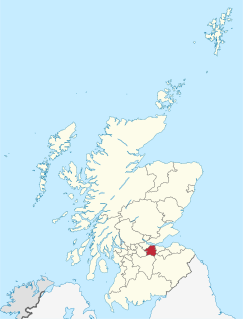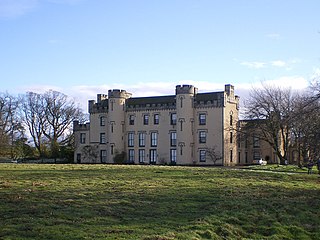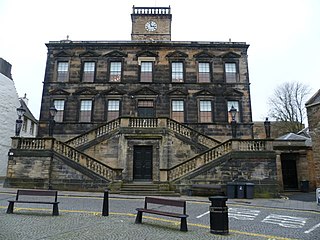
Sir Thomas Dalyell, 11th Baronet,, , known as Tam Dalyell, was a Scottish Labour Party politician who was a member of the House of Commons from 1962 to 2005. He represented West Lothian from 1962 to 1983, then Linlithgow from 1983 to 2005. He is particularly well known for his formulation of what came to be known as the "West Lothian question", on whether non-English MPs should be able to vote upon English-only matters after political devolution. He was also known for his anti-war, anti-imperialist views, opposing the Falklands War, the Gulf War, the War in Afghanistan and the Iraq War.

West Lothian is one of the 32 council areas of Scotland, and was one of its historic counties. The county, which was known as Linlithgowshire, was bounded geographically by the Avon to the west and the Almond to the east. The modern council area occupies a larger area than the historic county. It was reshaped following local government reforms in the late 20th century: some areas in the west were transferred to Falkirk; some areas in the east were transferred to Edinburgh; and some areas that had formerly been part of in Midlothian were added.

John Adrian Louis Hope, 1st Marquess of Linlithgow, 7th Earl of Hopetoun, was a British aristocrat and statesman who served as the first governor-general of Australia, in office from 1901 to 1902. He was previously Governor of Victoria from 1889 to 1895.

Marquess of Linlithgow, in the County of Linlithgow or West Lothian, is a title in the Peerage of the United Kingdom. It was created on 23 October 1902 for John Hope, 7th Earl of Hopetoun. The current holder of the title is Adrian Hope.

Victor Alexander John Hope, 2nd Marquess of Linlithgow, was a British Unionist politician, agriculturalist, and colonial administrator. He served as Governor-General and Viceroy of India from 1936 to 1943. He was usually referred to simply as Linlithgow.

Hopetoun House is a country house near South Queensferry owned by the Hopetoun House Preservation Trust, a charity established in 1974 to preserve the house and grounds as a national monument, to protect and improve their amenities, and to preserve the furniture, paintings, manuscripts, and other articles of historical interest associated with the house. The south wing of the house is occupied by the family of Adrian Hope, 4th Marquess of Linlithgow. The house is a Category A listed building and the grounds are included in the Inventory of Gardens and Designed Landscapes in Scotland.

Abercorn is a village and civil parish in West Lothian, Scotland. Close to the south coast of the Firth of Forth, the village is around 5 km (3.1 mi) west of South Queensferry. The parish had a population of 458 at the 2011 Census.
West Lothian was a Scottish county constituency of the House of Commons of the Parliament of the United Kingdom from 1950 to 1983. Its area corresponds to the Council area of West Lothian. It elected one Member of Parliament (MP) by the first past the post voting system.

Livingston Village is a village in West Lothian, dating back to the 12th century. Originally a farming village in West Lothian it is now in the heart of the town of Livingston.

Linlithgow was a county constituency of the House of Commons of the Parliament of the United Kingdom from 1983 to 2005. It elected one Member of Parliament (MP) by the first past the post system of elections.
This is a list of people who have served as Lord Lieutenant of West Lothian. The office was known as the Lord Lieutenant of Linlithgowshire until 1921.

Linlithgow is a town in West Lothian, Scotland. It was historically West Lothian's county town, reflected in the county's historical name of Linlithgowshire. An ancient town, it lies in the Central Belt on an historic route between Edinburgh and Falkirk beside Linlithgow Loch. The town is situated approximately 20 miles west of Edinburgh.

Clan Hope is a Scottish clan of the Scottish Lowlands.

General John Hope, 4th Earl of Hopetoun,, known as The Honourable John Hope from 1781 to 1814 and as Lord Niddry from 1814 to 1816, was a Scottish politician and British Army officer.

The House of the Binns, or simply the Binns, is a historic house in West Lothian, Scotland, the seat of the Dalyell family. It dates from the early 17th century, and was the home of Tam Dalyell until his death in January 2017.

Hersey Alice Hope, Marchioness of Linlithgow was a British aristocrat, who was the wife of John Hope, 1st Marquess of Linlithgow, who, as the 7th Earl of Hopetoun, was the first Governor-General of Australia 1901-1902.

Linlithgow Burgh Halls is a municipal structure at The Cross, Linlithgow, Scotland. The complex includes the Town House, the former headquarters of Linlithgow Burgh Council, which is a Category A listed building. and the Old County Hall, the former headquarters of West Lothian County Council, which is a Category B listed building.

County Buildings is a municipal structure in St Catherine Street in Cupar, Fife, Scotland. The building, which was the meeting place of Fife County Council, is a Category B listed building.

















